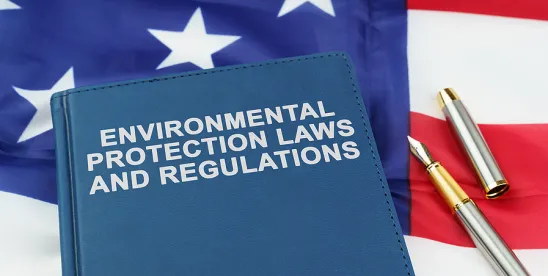These changes present both opportunities and challenges for the regulated community. Most of the rules mentioned are already the subject of ongoing D.C. Circuit litigation or may only be modified through traditional notice-and-comment rulemaking. A few address enforcement and related agency priorities, which may largely be addressed as a matter of agency discretion.
If you have not already done so, now is the time to evaluate your regulatory priorities and make plans to communicate those priorities to EPA through a combination of direct advocacy, industry group commenting or litigation (both challenging or supporting EPA efforts), and legislative engagement. Beveridge & Diamond has advised and represented clients – including in litigation – in virtually all of the rules mentioned in Administrator Zeldin’s March 12 announcement. Please contact the authors of this Alert or your usual Beveridge & Diamond contact to learn more about how we can assist you in achieving your regulatory goals.
Key Areas of Regulatory Reform
EPA’s announcements include a broad suite of deregulatory measures affecting industries across the energy, manufacturing, automotive, and infrastructure sectors. Notable areas of focus include:
- Climate Change: Reconsideration of the 2009 Endangerment Finding, which concluded that greenhouse gas emissions (GHG) threaten public health, in collaboration with the Office of Management and Budget and other relevant federal agencies. The Endangerment Finding was the threshold step allowing GHGs to be regulated under the Clean Air Act. EPA also intends to reconsider all of its prior regulations and actions that rely on the Endangerment Finding.
- Energy & Power Generation: Reconsideration of regulations of GHG emissions from fossil-fired power plants (Clean Power Plan 2.0), methane emissions from the oil and gas industry (NSPS OOOO b/c), wastewater rules for coal plants, and regulations governing cleanup of coal combustion residuals.
- Multi-Sector Air & Emissions Rules: Repeal or revision of key air quality rules, including the Mercury and Air Toxics Standards (MATS), the Good Neighbor Rule, and multiple National Emission Standards for Hazardous Air Pollutants (NESHAPs). EPA has suggested that it may, for the first time in history, use the national security exemption contained in Clean Air Act Section 112(i)(4) to extend compliance deadlines for certain NESHAPS by an additional two years while those rules are being considered.
- Transportation Sector: Reconsideration of vehicle greenhouse gas regulations, which could significantly impact fleet requirements and compliance strategies for automakers and suppliers.
- Regional/State Air Quality: Overhaul of the Regional Haze Program, reconsideration of particulate matter (PM2.5) standards, and working with states and tribes to address the backlog of State Implementation Plans and Tribal Implementation Plans (SIPs/TIPs) requiring action.
- Enforcement: EPA’s press release stated that it would “redirect enforcement resources to EPA’s core mission to relieve the economy of unnecessary bureaucratic burdens that drive up costs for American consumers (enforcement discretion).” In a memo from Acting Assistant Administrator for Enforcement and Compliance Jeffrey Hall also issued on March 12, EPA revised its National Enforcement and Compliance Initiatives to ensure that enforcement does not discriminate based on race and socioeconomic status or shut down energy production, and that it focuses on the most pressing health and safety issues.
Reconsideration: What is Required?
Most of the rules addressed in EPA’s announcement were adopted through notice-and-comment rulemaking procedures and will require a similar rulemaking procedure to rescind or rewrite the rule. Hence, EPA will need to justify its actions by developing technical, economic, and scientific support for its proposals, and it will need to identify legal arguments to justify rescission or rollback, or both. For many of these rules, the task will be complicated by prior EPA factual/technical findings and legal interpretations, and EPA will need to develop a persuasive justification for changing course. If EPA does not thoroughly develop an administrative record supporting its decisions, it risks reversal in court. Potential reductions in staff and financial resources at EPA present opportunities for industry to provide key technical and legal support for the reconsideration proposals.
Next Steps for Regulated Entities
Beveridge & Diamond has a long-standing track record of advising clients through environmental rulemakings, federal permitting challenges, and litigation (including before numerous federal appellate courts and the U.S. Supreme Court). Our team includes former EPA and Department of Justice officials and other regulatory and litigation strategists who can assist with the following recommended actions.
- Regulatory Impact Assessments. Evaluating how these rollbacks affect your permitting, compliance, and operational strategies.
- Public Comment & Stakeholder Engagement. Assisting you in submitting comments during EPA’s rulemaking process (which may differ for each of the rules mentioned) to ensure (i) industry perspectives are heard, (ii) a robust administrative record is created and (iii) you preserve your right to judicial review.
- Litigation & Defense Strategy. Preparing for potential legal challenges to the new regulations and supporting industry-led interventions.
- Providing Technical & Economic Analyses. Supplying data-driven arguments on how regulatory changes impact operations, costs, and competitiveness.
- Collaborating with Trade Associations. Leveraging collective industry influence to shape rulemaking and legislative advocacy.
- Engaging with Congress & State Agencies. Working with policymakers to reinforce industry priorities and ensure favorable regulatory interpretations at the state level.
- Monitor State Actions. Many states are likely to either challenge EPA actions or to enact state-level policies to fill the perceived void in federal actions. For example, New York recently enacted a “Climate Superfund” law requiring large GHG emitters to pay for a climate mitigation measures, and other states, notably including California, are now using the New York law as a model for similar legislation in their states.
Given the broad scope of EPA’s deregulation effort, we encourage industry leaders to act now to help shape these regulatory outcomes. We welcome the opportunity to discuss how these changes impact your business and how we can support your strategic response.








 />i
/>i
